But if you close your eyes…
You can’t help but be impressed by the noble city of Berlin with its majestic architecture and aura of energy but many of its principal tourist attractions are stark reminders of the horrors that have defined it within living memory.
Berlin presented us with a dilemma. Do we ignore more recent history in favour of the distant past by spending what time we had at sites like the magnificent Museum Island, or ‘Museumsinsel’ with its six thousand years of art and cultural history, the retail heaven of Friedrichstrasse, or acknowledge Berlin’s role in infamy with time at The Topography of Terror exhibition and ‘The Wall’.
With only a day in the capital we elected to visit as many different places as we could within walking distance of the central Gendarmenmarkt – one of Berlin’s most magnificent squares that buzzes day and night.
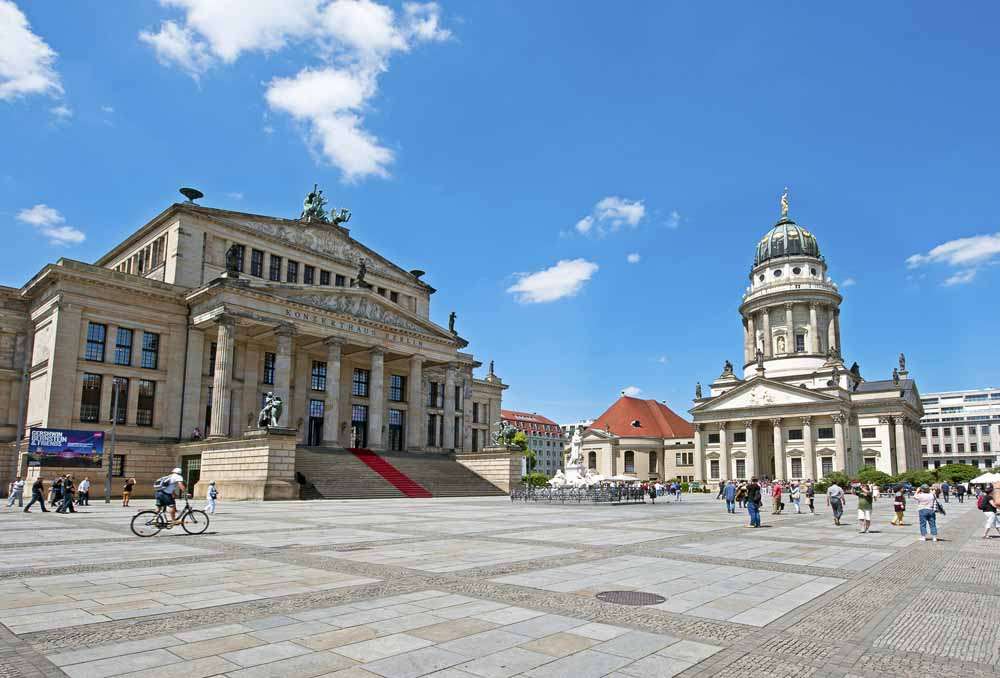
Gendarmenmarkt showing the Konzerthaus and French Church with monumental statue of renowned German poet Friedrich Schiller
So, armed with a tourist map, we stood in the middle of Gendarmenmarkt and were immediately overwhelmed by the scale of the three significant buildings in one location – those of the German Church and French Church, each flanking the Palladian Konzerthaus. The churches are in fact museums but with a limited time available to us we decided that browsing museums would soon eat into our schedule and headed north towards Unter den Linden.
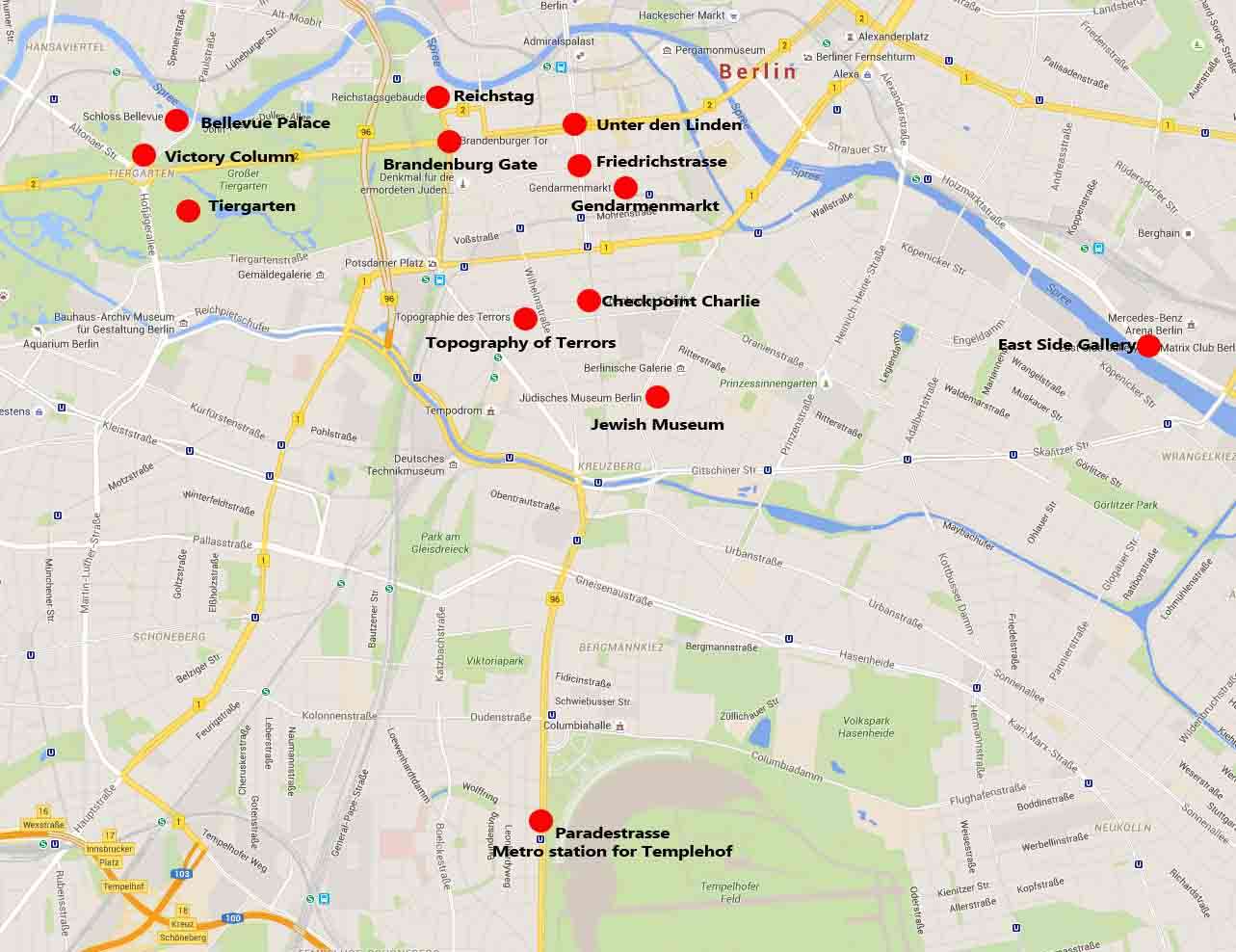
This east-west oriented boulevard, whose name simply means ‘under the Linden (lime) trees’ is a popular recreational area with a leafy pedestrian avenue running between two lanes of traffic that roughly joins the Spree river in the east to the Brandenburg Gate in the west. It’s a pleasant stroll in the sun albeit, as with many city centres, there’s a lot of construction work underway to foil a straight and unhindered walk.
Towering at the western end of Unter den Linden is the Brandenburg Gate; a symbolic triumphal arch for conquering armies, it’s probably the defining landmark of Berlin. Commissioned by King Frederick William II of Prussia as a sign of peace, it has served as both a symbol of the tumultuous history of Europe and Germany, but also of subsequent European unity and peace.
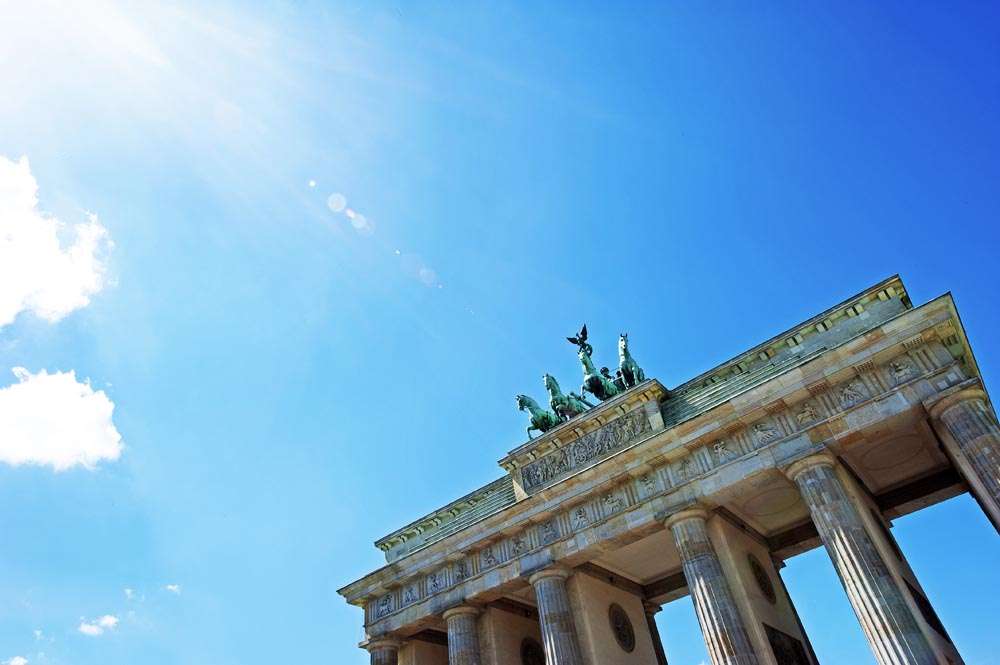
Brandenburg Gate – symbol of peace that has witnessed so much tumult
If you’re feeling particularly energetic then a tour around the Tiergarten (Animal Garden) is worthwhile and the beautiful parkland has several notable sites/sights within it, such as the President’s residence, Bellevue Palace, and the imposing Siegessaule, or Victory Column.
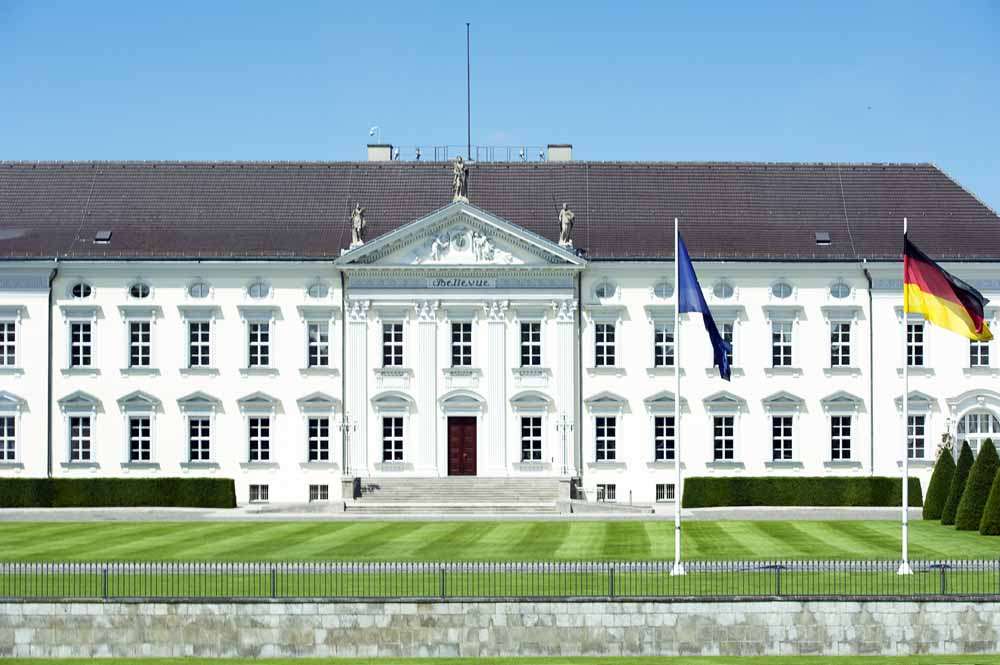
Bellevue Palace – residence of the President
Unless you’re broad minded watch out that you don’t stumble across families of naturists who have monopolised part of the Tiergarten’s grassy areas for sunbathing.
One block to the north of the Gate is the Reichstag. With the fire that destroyed much of it in 1933 being the catalyst for the Nazis to suspend human rights, the building existed in a vacuum almost until 1999, when with its completed refurbishment it once again became the meeting place of the German parliament: the modern Bundestag.

The Reichstag – with its distinctive glass and steel dome; symbol of German transparency
Interestingly it’s the new significant glass and steel cupola at its zenith that was designed to symbolise ‘transparency’ in Germany that perhaps encapsulates the Berliner’s attitude towards the many disturbing landmarks within its boundaries – almost a statement of ‘be aware and never forget these events happened in order that we do not repeat them but celebrate their passing.’
That said, we by-passed the memorial to the ‘Murdered Jews of Europe’ but did find ourselves at the Topography of Terror open air museum.

‘Topography of Terror’ exhibition on the razed site of the 2nd WW S.S. and Gestapo headquarters adjacent to the longest surviving section of the outer Berlin Wall
It is located on Niederkirchnerstrasse, formerly Prinz-Albrecht-Strasse. The site of the former Gestapo and S.S. headquarters that was damaged during, and razed to the ground after the Second World War.
It also has one of the longest remaining stretches of the outer Berlin Wall adjacent to it. In a covered and glazed walkway alongside is the timeline of terror that swept through Berlin during the Nazi persecution of Jewish and marginalised people – truly chilling.
- Checkpoint Charlie today
- ..and then
- Remnants of oppression
- …and division
By contrast but no less poignant is the reconstructed Checkpoint Charlie; now simply a Disney parody of its former oppressive self, with actors playing the part of American soldiers it marks one of the best known gateways to the West from Eastern Germany during the ‘cold war’ years up until 1989. The surroundings are of more interest with photographs of the area during the cold war and remnants of the wall and memorabilia at the museum. The ‘Wall’ divided the two halves of Berlin for an incredible 140kms.
- Artists refresh work
- at the East Side Gallery
- Symbols of resistance,
- hope
- and memories
- never forgotten
A second inner wall was constructed within the East, remains of which can be seen at the ‘East Side Gallery’ on Muhlenstrasse near the River Spree. We detoured to see this at the end of our city-wide marathon walk. This is particularly interesting as it is a living art gallery, decorated by numerous artists who continually update and refresh their works of art along its length.
From Checkpoint Charlie we pass the Jewish Museum which is constructed with dramatic zig-zag architecture but by this time we were desperate to eat something, so headed back to Gendarmenmarkt to complete the circle.
When we’re hiking around a city we seldom devote the time to a gastronomic lunch or dinner as it ‘eats’ too much time.
Today we grab a table outside in the sun at the colourful, traditionally Bavarian restaurant, Augustiner. It’s a street front restaurant behind the French church in the main square and is buzzy and friendly. We treat ourselves to a quick ‘pigs trotter’ which seems like half a pig with acres of crackling cooked to perfection sitting in a sauce of onions and vegetables – all helped down with a glass of local beer.
- Traditional Bavarian
- bar, colourful restaurant
- and lively staff
- with delicious food
It was quickly served and equally as quickly devoured – simply delicious.
We’re soon back on our feet and in the meantime I’ve had the notion that ‘we’d’ like to visit Templehof Airport! It’s the huge art deco crescent that Hitler built for the Olympics of 1936 but which really shot to fame for its role in the Berlin Airlift when the allies spent a year supplying a beleaguered West Berlin that had been deliberately cut off by the Soviets in order to force it into submission.
 I have to confess to a certain inexplicable affinity with old airports (as I’ve always loved flying) which I have to say isn’t shared by Cherrie – but nevertheless, after a short Metro ride (just five stops from Stadtmitte – Paradestrasse) we end up at Templehof. It’s no longer used (the old airfield is now for public recreation) and the terminal is occasionally open but access to the apron is permanently locked. I did manage to hike Cherrie around the fenced perimeter in order to ‘appreciate’ the architecture but time was getting on and I felt that there would be a major sense of humour failure if we didn’t get back to the centre.
I have to confess to a certain inexplicable affinity with old airports (as I’ve always loved flying) which I have to say isn’t shared by Cherrie – but nevertheless, after a short Metro ride (just five stops from Stadtmitte – Paradestrasse) we end up at Templehof. It’s no longer used (the old airfield is now for public recreation) and the terminal is occasionally open but access to the apron is permanently locked. I did manage to hike Cherrie around the fenced perimeter in order to ‘appreciate’ the architecture but time was getting on and I felt that there would be a major sense of humour failure if we didn’t get back to the centre.
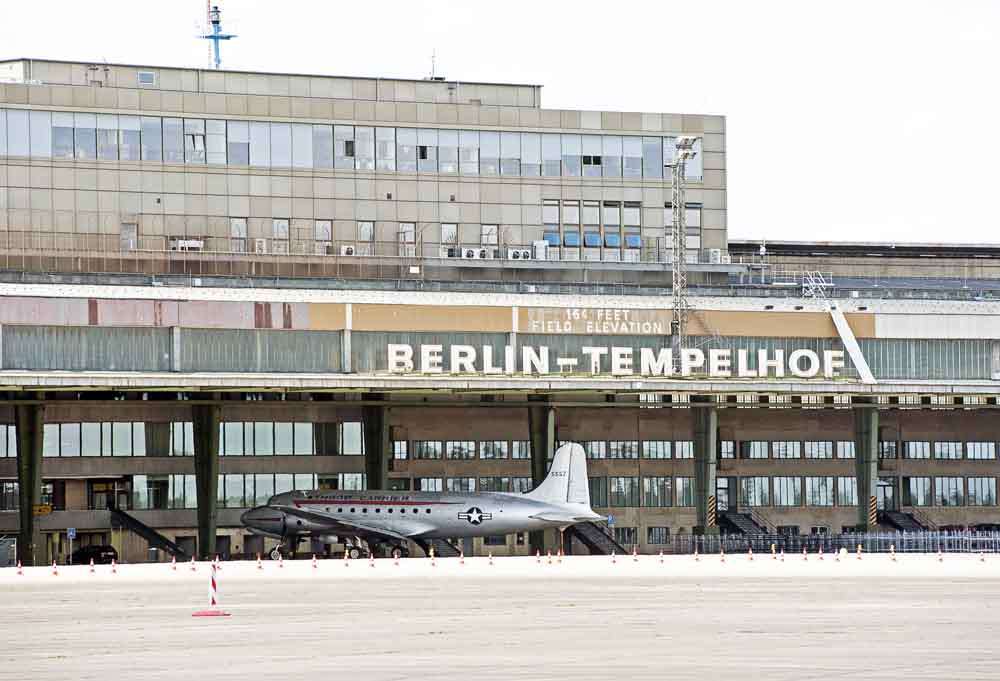
Art Deco airport built for the Olympics of 1936 but used for the more Olympian effort of the Berlin Airlift, 1948-9
Although we covered a tremendous distance within the city and enjoyed immensely the wide boulevards, majestic and mesmerising landmarks…and pork crackling…Berlin needs much more time. We need to re-visit in order to spend time on Museum Island, at the very least.
We don’t have a particular penchant for war and brutality but the legacy of it is widely distributed around Berlin and difficult to circumnavigate. Berlin also offers many of the attractions that any modern city with a long history exhibits but we wondered what its inhabitants must think of the constant pilgrimage of thousands to parts of the city that are perhaps now best left behind them.
Berlin, at face value, is a vibrant energetic modern city that still bears the all too recent scars of terror and turmoil. We left the city impressed by its grandeur and ‘presence’ and chose to regard it as a living, thriving museum to European history – as it still continues to be created.
- A changing city
- with echoes of the past
- and today’s world culture
![]()
It was a few days after that, by chance, we once again heard Bastille’s old 2013 song ‘Pompeii’ about people in the Italian city and couldn’t help but see the poignant similarity with Berlin – what do you think?
Pompeii
[Verse 1]
I was left to my own devices
Many days fell away with nothing to show
[Pre-Chorus]
And the walls kept tumbling down in the city that we love
Great clouds roll over the hills bringing darkness from above
[Chorus]
But if you close your eyes
Does it almost feel like nothing changed at all?
And if you close your eyes
Does it almost feel like you’ve been here before?
How am I going to be an optimist about this?
How am I going to be an optimist about this?
[Verse 2]
We were caught up and lost in all of our vices
In your pose as the dust settled around us
[Chorus]
[Bridge]
Oh where do we begin, the rubble or our sins?
Oh where do we begin, the rubble or our sins?
[Pre-Chorus]
And the walls kept tumbling down in the city that we love
Great clouds roll over the hills bringing darkness from above
[Chorus]
But if you close your eyes
Does it almost feel like nothing changed at all?
And if you close your eyes
Does it almost feel like you’ve been here before?
How am I going to be an optimist about this?
How am I going to be an optimist about this?
If you close your eyes
Does it almost feel like nothing changed at all?
Written by Dan Smith and recorded by Universal
Rostock

Berlin is definitely a ‘must see’ if you’ve not yet been there and you could easily spend a few days to cover it all – but if you have a little more time why not hop on the ‘Regio’ suburban train that will take you to the UNESCO World Heritage Site of Rostock, once one of the thriving cities of the Hanseatic League.























